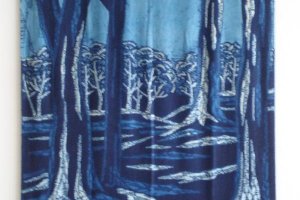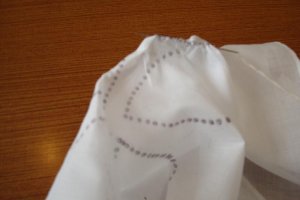Visit the textile museum in Arimatsu for a chance to see the amazing patterns they create or try it for yourself in their hands-on experience!
Men and women have very specific roles in the crafting process Arimatsu is famous for. A point of pride for the women is the speed with which they can complete their task. In fact, they say that a girl "should know her family’s distinct pattern with her eyes shut before she is twelve years old."
Men create the patterns on the fabric for the specially detailed designs. They carefully design the pattern and cut or chisel it out of paper. Then it is printed onto the fabric using a brush and special washable ink created from flowers. The design is then stitched or tied by the women before it’s off to specialist tie-dye factories to be dyed. After dying, the stings are removed (this can take up for four days on a large piece with a complicated design!) to reveal the final result.
Arimatsu is an area which has been swallowed by the growth of Nagoya, but remains very true to its roots, which go way back. They go so far back, that there are Edo-period woodblock prints of the area.
Do you remember those shirts that were popular in the late 90’s? They were puckered and often dyed with a rainbow pattern and would stretch out when you put them on? That’s a style of shibori – tie dye technique – used by the artisans of Arimatsu.
If you choose the hands-on experience, you can choose from a variety of items from hankies to t-shirts. The workshop takes place on the second floor in a large room that can accommodate groups. The instructors are experienced and patient. Though they may not speak English, it’s easy enough to follow them by imitating their actions. When you’re done, choose a dye color (if you’re in a group, you have to vote) and you’re done! The biggest draw-back to the hands-on experience is that they only list prices on the website for shipping to Nagoya and the surrounding area and it takes ten to fourteen days to get it. I’m not sure if they’ll be willing to ship further, so short-term travelers beware.
There is a showroom of pieces created by the artisans of Arimatsu. The pieces range from kimono and yukata to curtains and beyond. What they create with these methods is rather amazing. A video available in Japanese or English is available to teach visitors about the history and complex creative process of Arimatsu shibori.
When you’re all done, head down to the shop below and take home a piece of Arimatsu. They have all kinds of shibori items here: eco bags, clothes, purses, household goods, and more. You may encounter their town mascot Shibori-chan while you’re there. Shibori-chan, a roll of brightly dyed fabric, is slightly terrifying, but well-intentioned, so just smile and take a picture with her!



































